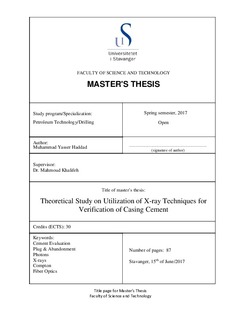| dc.contributor.advisor | Khalifeh, Mahmoud | |
| dc.contributor.author | Haddad, Muhammad Yasser | |
| dc.coverage.spatial | Norway, Stavanger | nb_NO |
| dc.date.accessioned | 2017-10-26T08:39:45Z | |
| dc.date.available | 2017-10-26T08:39:45Z | |
| dc.date.issued | 2017-06 | |
| dc.identifier.uri | http://hdl.handle.net/11250/2462283 | |
| dc.description | Master's thesis in Petroleum engineering | nb_NO |
| dc.description.abstract | Establishing a hydraulic seal that prevents flow is the primary objective of any cement job, as it is essential throughout the life of a well. Evaluation of the cement in the annulus must be done to verify its quality. Tools based on acoustics are market leaders, although having limitations that may cause erroneous conclusions. It is of interest to find tools based on other principles that either replaces or supplements acoustic logs.
The thesis covers briefly barrier establishment, acoustic and fiber optic principles. A preliminary investigation into x-ray viability for cement evaluation has been done. Photon interactions, generation, detection and their subsequent challenges were also discussed. Heavy emphasis was placed on Compton scattering, as this is the basis for allowing both the transmitter and detector to be placed on the same side. To determine the viability of x-rays downhole several scenarios were created. We considered a single photon traveling through casing and a selection of materials before it is reflected at an angle.
Initial results based scenarios with concentric and eccentric cemented 958 casing showed that investigation of the cement-formation interface is too demanding of x-rays as it failed to provide sufficient penetration of the casing on its return. The attenuation due to Compton scattering is significant, dependent on energy level and angle of the beam it can reach 80% attenuation. The angle of reflection or transmission will provide additional attenuation due to added length of travel path for the beam. Material density must be taken into consideration, as it influences the attenuation rate of the x-rays beam. The beam experienced high degree of attenuation when passing through casing, the attenuation contrast between casing and cement was discernable. Materials such as foamed cement, seawater and gas were also investigated. All of the latter materials allowed for increased transmission compared to casing and cement. The contrast between foamed cement and seawater was low and of concern for applicability of x-rays for foamed cement evaluations. Gas channels in cement are easily detected if the size of channel is sufficient.
Investigation of the cement-formation interface did not provide satisfactory results due to the inability of the beam to return to the detector before complete attenuation. Reduction of the depth of investigation may provide satisfactory results and should be investigated. | nb_NO |
| dc.language.iso | eng | nb_NO |
| dc.publisher | University of Stavanger, Norway | nb_NO |
| dc.relation.ispartofseries | Masteroppgave/UIS-TN-IPT/2017; | |
| dc.rights | Navngivelse-Ikkekommersiell 4.0 Internasjonal | * |
| dc.rights.uri | http://creativecommons.org/licenses/by-nc/4.0/deed.no | * |
| dc.subject | petroleumsteknologi | nb_NO |
| dc.subject | petroleum engineering | nb_NO |
| dc.subject | X-rays | nb_NO |
| dc.subject | boreteknologi | nb_NO |
| dc.subject | cement evaluation | nb_NO |
| dc.subject | plug & abandonment | nb_NO |
| dc.subject | p&a | nb_NO |
| dc.subject | photons | nb_NO |
| dc.subject | fiber optics | nb_NO |
| dc.subject | compton | nb_NO |
| dc.title | Theoretical Study on Utilization of X-ray Techniques for Verification of Casing Cement | nb_NO |
| dc.type | Master thesis | nb_NO |

